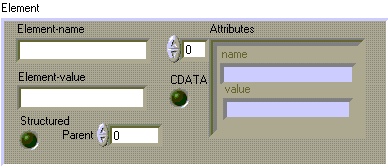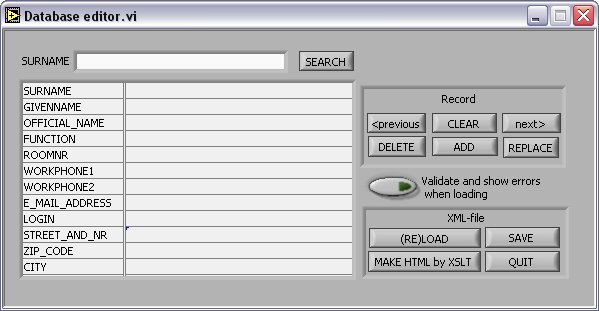Welcome to http://labxml.sourceforge.net/
An XML-toolkit for Labview
-------------
LibXML-toolkit Version 1.2
------------
-September, 28, 2005-
------------
Release notes
-------------
LibXML-toolkit Version 1.2
------------
-September, 28, 2005-
------------
Release notes
The heart of the toolkit is the the control MSXML Element.ctl.
This cluster is, as an element in an 1D-array, the Labview-interface to the DOM-model.

Element contains:
| MSXML Create New XML-file.vi | Creates a new XML-file with root-element name and without any subtags |
| MSXML Edit XML.vi | There are 3 edit modes:
|
| MSXML Open XML-file.vi | Loads the XML-file as an XML-document into memory |
| MSXML Read XML-tree.vi | This is a recursive VI which reads the complete tree of SelectedNode belonging to the loaded XML-document and adds it to "XML-tree in" resulting isn "XML-tree out". SelectedNode could be the node found by the select node vi. The parent input should refer to the hierarchical parent in the XML-tree to which the tree of the selected node is added. The parent-input is 0 if "XML-tree in"is empty. There will be no check whether the parentnr exists nor if this is the right position for the child to be added to the XML-tree. |
| MSXML Save XML.vi | Backup the old file and saves the document to file. The document will not be closed and references are still valid |
| MSXML Select nodes in document.vi | This Vi searches the XML Document with the querystring according tothe Xpath protocoll and returns the number (length) of the nodes found as well as the first Node found. If not found "not found"will be set true |
| MSXML Translate with XSLT.vi | Will use the XSL-file to generate a file from the XML-data, like an HTML-file. |
| MSXML Validate.vi | This VI will validate the XML-document when "Validate on Parse" is TRUE (MSXML Open XML-file.vi) |
